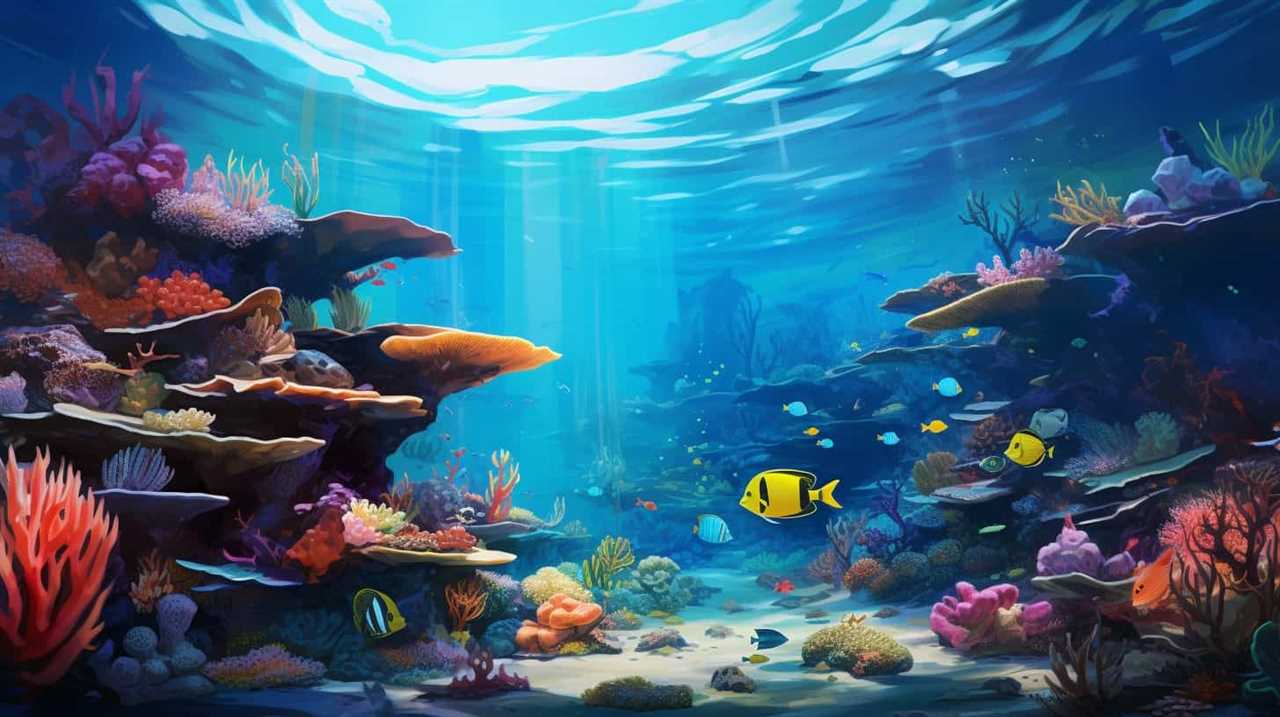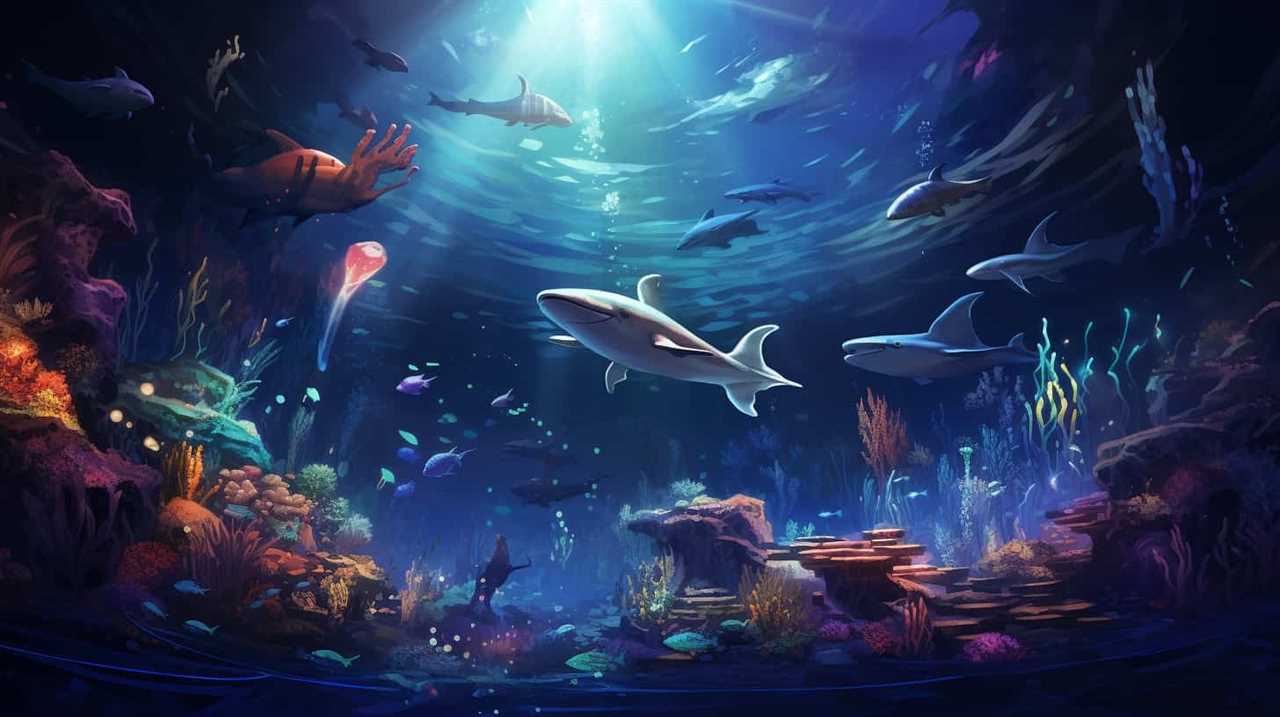As we dive into the depths of the ocean, we embark on a captivating journey into the world of underwater soundscapes.
In this article, we explore how the acoustics of the underwater environment impact the lives of sea creatures.
From the mesmerizing communication and navigation techniques of marine life to the adaptations they have developed to survive in this acoustic realm, we uncover the intricate relationship between sound and biodiversity beneath the surface of the seas.
Join us as we delve into the captivating realm of underwater acoustics.

Key Takeaways
-
Underwater acoustics and its impact on marine life: The study of sound propagation in water and understanding underwater noise is crucial in identifying the effects of human activities on marine life, including disruption of communication, behavior changes, and physical damage caused by noise pollution. It is important to develop strategies to mitigate noise pollution and understand the impacts for conservation and management.
-
Communication and navigation in the ocean: Echolocation plays a remarkable role in marine animals, enabling them to locate prey and avoid obstacles. Social behavior and complex vocalizations are important in aquatic soundscapes, allowing for coordination of group movements through communication and body movements.
-
Adaptations of sea creatures to acoustic environments: Sea creatures have specialized hearing mechanisms and exhibit behavioral responses to acoustic stimuli. Their sensory perception and interpretation of acoustic signals are crucial for effective navigation and communication. They differentiate and respond to variations in sound frequency, intensity, and directionality.
-
Studying underwater soundscapes and biodiversity: The impact of acoustics on sea creatures and biodiversity is significant. Assessing marine ecosystem health through studying underwater soundscapes is essential, especially in the context of climate change and its effects on soundscapes. Understanding the relationship between acoustics and biodiversity has conservation and management implications.

The Science of Underwater Acoustics
We will delve into the fascinating realm of underwater acoustics and explore how it affects the lives of sea creatures.
The science of underwater acoustics involves the study of sound propagation in water and its impact on marine organisms. One key aspect of this field is understanding underwater noise, which refers to sounds produced by human activities such as shipping, construction, and sonar technology.
These noises can have detrimental effects on marine life, including disruption of communication, changes in behavior, and even physical damage to sensitive organs. Sonar technology, in particular, emits intense sound pulses that can disorient and harm marine mammals, leading to strandings and even death.
Impacts of Noise Pollution on Marine Life
The detrimental impacts of noise pollution on marine life include disruption of communication, changes in behavior, and even physical damage to sensitive organs. Noise pollution, often caused by anthropogenic activities such as shipping, sonar, and offshore construction, has significant effects on marine organisms.

-
Communication disruption: Underwater noise can mask or interfere with crucial communication signals used by marine species. This disruption can lead to decreased reproductive success, reduced foraging efficiency, and increased predation risk.
-
Behavioral changes: Exposure to chronic noise can alter the behavior of marine animals. This may include disturbance of feeding, migration, and mating patterns, ultimately affecting their survival and population dynamics.
-
Physical damage: High-intensity noise can cause physical harm to marine organisms. For example, some species may experience tissue damage, hearing loss, or even death due to the intense acoustic energy.
To mitigate the effects of noise pollution, various strategies can be employed, such as implementing regulations to reduce anthropogenic noise sources, establishing marine protected areas, and developing quieter technologies for underwater activities.

Understanding the impacts of noise pollution on marine life is crucial for effective conservation and management strategies. Now, let’s delve into the fascinating world of communication and navigation in the ocean.
Communication and Navigation in the Ocean
As we dive deeper into the fascinating world of the ocean, communication and navigation become essential aspects for sea creatures to navigate their aquatic soundscapes.
Echolocation is a remarkable ability found in many marine animals, such as dolphins and whales, that allows them to emit sound waves and interpret the returning echoes to perceive their surroundings. This sophisticated form of communication enables them to locate prey, avoid obstacles, and navigate through their vast ocean habitats.
Additionally, social behavior plays a crucial role in the communication and navigation of marine species. Many sea creatures, like fish and marine mammals, rely on complex vocalizations and body movements to communicate with their group members, maintain social bonds, and coordinate group movements.

Understanding the intricate ways in which ocean creatures communicate and navigate is vital to comprehending their adaptations to acoustic environments and how they’re impacted by external factors.
Adaptations of Sea Creatures to Acoustic Environments
Understanding the adaptations of sea creatures to acoustic environments is crucial for comprehending their ability to thrive and survive in their underwater habitats. These adaptations allow them to effectively navigate and communicate in a complex soundscape.
Here are three key adaptations that enable sea creatures to interact with their acoustic surroundings:
-
Specialized hearing mechanisms: Sea creatures have evolved specialized auditory structures to detect and process sound waves underwater. These structures, such as swim bladders, otoliths, or lateral line systems, enable them to perceive and interpret sounds in their environment.

-
Behavioral responses: Sea creatures exhibit a range of behavioral responses to acoustic stimuli. These responses can include changes in swimming patterns, vocalizations, or the ability to locate and capture prey using sound cues. These adaptations allow them to navigate, communicate, and interact effectively within their acoustic environments.
-
Sensory perception: Sea creatures have developed heightened sensory perception to detect and interpret subtle acoustic signals. They can discern variations in frequency, intensity, and directionality of sounds, allowing them to differentiate between different sounds and respond accordingly.
Studying Underwater Soundscapes and Biodiversity
Continuing our exploration of underwater soundscapes, we delve into studying the impact of acoustics on sea creatures and their biodiversity.
Understanding how underwater soundscapes are affected by climate change is crucial for assessing the health of marine ecosystems. Changes in sea surface temperature and ocean acidification can alter sound transmission, affecting the communication and behavior of marine organisms.

Additionally, increased noise pollution from human activities such as shipping, seismic exploration, and offshore construction can disrupt natural soundscapes and have negative consequences for marine life.
By studying underwater soundscapes and their relationship to climate change, we can gain valuable insights into the health of marine ecosystems and the potential impacts of human activities.
This knowledge is essential for implementing effective conservation strategies and preserving the biodiversity of our oceans.
Frequently Asked Questions
How Does the Presence of Underwater Noise Pollution Affect the Communication and Navigation Abilities of Marine Animals?
Underwater noise pollution can have detrimental effects on the communication and navigation abilities of marine animals. Coral reefs and marine mammal populations are particularly impacted by anthropogenic noise, disrupting their natural behaviors and causing long-term consequences.

What Are Some Specific Adaptations That Sea Creatures Have Developed to Survive in Different Acoustic Environments?
Sea creatures have developed various adaptations to survive in different acoustic environments. Echolocation adaptations allow them to navigate and locate prey, while vocalization strategies enable communication and mate attraction. These adaptations enhance their survival and reproductive success.
How Do Scientists Study Underwater Soundscapes and Biodiversity to Understand the Impact of Acoustics on Sea Creatures?
We study underwater soundscapes and biodiversity to understand the impact of acoustics on sea creatures. By conducting research in this field, we gain insights into the complex relationships between sound, marine ecosystems, and the survival of marine species.
Can Underwater Noise Pollution Have Long-Term Effects on the Reproductive Behavior of Marine Animals?
Underwater noise pollution can have long-term effects on the reproductive behavior of marine animals. It can lead to population decline and negatively impact the health of these creatures.
Are There Any Efforts Being Made to Reduce Noise Pollution in the Ocean and Protect Marine Life?
We are actively working towards underwater noise pollution mitigation and have implemented various conservation efforts for marine life. These initiatives aim to reduce the negative impact of noise pollution on sea creatures and protect their habitats.

Conclusion
In conclusion, the study of underwater acoustics and its impact on marine life reveals the crucial role of sound in communication, navigation, and adaptation for sea creatures.
While some may argue that noise pollution is inevitable in our increasingly industrialized world, it’s important to acknowledge the potential harm it can cause to the delicate balance of marine ecosystems.
By understanding and mitigating the effects of human-generated underwater noise, we can strive to protect and preserve the biodiversity and well-being of these incredible creatures.










